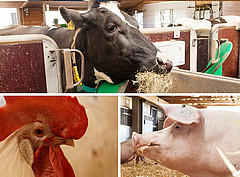54 Million Euros: German Council of Science and Humanities Endorses Center for Animal Sciences [27.04.18]
BREAKING NEWS: University of Hohenheim as Germany's no. 1 university for agricultural research is to be the location for a nationally important scientific center
Animal well-being and animal health, reduced use of antibiotics, better use of resources, and reduced environmental effects: A key factor in livestock animals’ characteristics are the interactions between the animal and the billions and billions of microorganisms that are located in particular in the intestinal tract. Up to now, these processes have in large part not been understood. With the new “Hohenheim Center for Livestock Microbiome Research (HoLMiR)”, the University of Hohenheim is to work on closing this gap in knowledge. The decision was made by Germany’s Council of Science and Humanities in today’s spring meeting in Trier. The final decision on funding the research buildings will be made by the Joint Science Conference (GWK) on 9 June 2018 based on the recommendation of the Council of Science and Humanities. The University Building Office estimates construction costs at around 47 million euros and an additional 7 million euros for equipment.
A key factor in livestock animals’ characteristics are the interactions between the animal and the billions and billions of microorganisms that are located in particular in the intestinal tract. With the new “Hohenheim Center for Livestock Microbiome Research (HoLMiR)”, the University of Hohenheim is to work on closing this gap in knowledge. | Images: University of Hohenheim / Dauphin(2) + Emmerling(1)
In human medicine, knowledge has increasingly grown about the importance of microorganisms in the intestines. The make-up and behavior of this complex system influence even people’s mental states and behavior. Dysfunctions seem to be partially responsible for chronic illnesses or metabolic disorders such as obesity and diabetes.
What is even more complex and far less researched are the interactions between livestock and the billions and billions of microorganisms in their intestinal tracts. This is such an expansive community that kilograms of microbe mass grow daily in a cow.
Results Provide Key to Many Problems in Animal Keeping
“We know that these microorganisms play an important role in how animals behave, how susceptible they are to illness, whether they can utilize scarce feed resources well, and how many environmentally dangerous substances they excrete. These substances include climate cases, for example methane produced by cows,” explained Prof. Dr. Markus Rodehutscord, spokesperson for the 10 leading researchers at the future Hohenheim Center for Livestock Microbiome Research (HoLMiR).
Intensive basic research about the types, mechanisms, genetics, and other influences on the symbiotic community of animal and microorganisms is intended to deliver the key to solving applied problems. “In the long term, we’re hoping to find new prevention and therapy approaches for using medications, creating breeding programs for adapted races that need less feed, or developing high-quality food production with fewer negative effects on the environment,” stated Prof. Dr. Rodehutscord.
His summary: “This research building will enable the University of Hohenheim to pursue an exciting interdisciplinary research program that we believe is highly relevant to society.”
Science Minister Theresia Bauer Commends Success for the State
“The funding for the ‘Hohenheim Center for Livestock Microbiome Research’ is a great success for the University of Hohenheim and the state of Baden-Württemberg. The decision attests to the University’s leading position in livestock research. With an innovative research concept and the bundling of expertise from various departments, the University’s proposal prevailed against many other proposals from all over Germany,” stated Science Minister Theresia Bauer.
Prof. Dr. Stephan Dabbert from the University of Hohenheim gave his thanks for the support from the state of Baden-Württemberg, which pushed forward the project together with the University. “Thanks to the project funding from the Ministry of Science, we were able to carry out important preliminary work. I would also like to thank Minister of Science Theresia Bauer personally for her political support and intensive assistance.”
Prof. Dr. Dabbert also expressed his gratitude to the core team of animal scientists, microbiologists, and biostatisticians who prepared and worked on the HoLMiR concept over the course of several years: “Today’s success shows that the University of Hohenheim is particularly successful when it builds on the unique strengths and special profile that make it unique in Germany.”
Possible Start of Construction in 2020
The estimated costs for the Hohenheim Center for Livestock Microbiome Research (HoLMiR) are around 47 million for construction. Another 3 million euros for basic equipment and 4 million for large equipment will also be needed.
Module I of the research building will be specialized laboratories with in vitro and tissue technology as well as cutting edge major instrumentation. The planned location is south of the Biology building to make use of synergies with existing specialized labs.
Module II of the research building will be the animal experiment unit. There, up to 250 cows, sheep, pigs, and chickens will be kept for use as experimental animals. Special pens will make it possible to keep fowl in a sterile environment, for example. Others will enable researchers to measure the composition of air the animals breathe and the metabolic gases they release. The location will be at the Meiereihof research station to make use of synergies with the institutions there.
The new buildings will have a total area of around 3,500 square meters. They are to serve as a platform for 10 working groups and 3 young scientist research groups with a total of 40 scientific and 20 non-scientific employees.
The preparation work is to start in 2019. Construction will tentatively start in 2020. The planned construction time is 2 years. Construction work was made possible by the Master Plan 2030 in which the University, state, and city of Stuttgart agreed on guidelines to build on the historical campus.
Text: Klebs
Contact for press:
Prof. Dr. Markus Rodehutscord, University of Hohenheim, Institute of Animal Science / Department of Animal Nutrition
T +49 711459 22420, E markus.rodehutscord@uni-hohenheim.de
Back to

